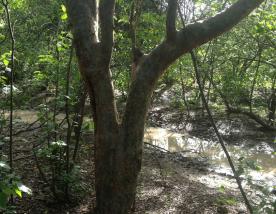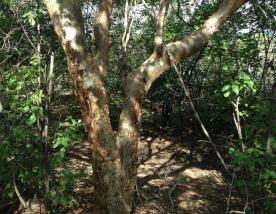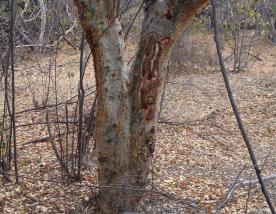Imburana is known by many names: Amburana, amburana-de-cambão, imburana, imburana-braba, imburana-de-espinho, imburana-femea, imburana-vermelha, imburaninha, imburaninha do sertão, imburaninha de caboclo, jamburana and emburana. Its popular name comes from two words of the Tupi language: y-mv-u (tree of water) and ra-na (false), thus forming the word imburana (false imbu).
The imburana de cambão (Commiphora leptophloeos) is a tree native to Caatinga. The name Caatinga comes from the Tupi: ka’a (mata: forest) + tinga (white). It is the only truly brazilian biome, which means that the majority of its biological heritage cannot be found anywhere else on the planet.
The name Caatinga is derived from the colorless appearance of the landscape during the dry season: the majority of the bushes and plants lose their leaves and the trunks are colorless and dry. Caatinga covers an area of nearly 850,000 km2, nearly 10% of the total territory of Brazil, a continuous zone including parts of the States of Paraíba, Piauí, Ceará, Rio Grande do Norte, Maranhão, Pernambuc, Alagoas, Sergipe, Bahia (in the Northeast of Brazil) and the northern part of Minas Gerais (in the Southeast of Brazil).
It is one of the most fragile biomes of Brazil. The intensive exploitation of its soil and natural resources in the course of hundreds of years of occupation, now associated with the images of poverty and drought, have caused the severe degradation of Caatinga. According to the Wikipedia, however, recent research has shown, that this biome possesses particular richness in terms of biodiversity and characteristic phenomena.
Imburana de cambão
Nomenclature
Basic information on the plant
Scientific name: Commiphora leptophloeos (Mart.) J.B. Gillett
Family: Burseraceae
Also known as: Bursera leptophloeos (Mart). and Icica leptophloeos (Mart).
Habitat/location
Northeastern Brazil, in Caatinga along with shrubs in calcareous soils, which are often found in the central valley of the Sãn Francisco River. It may also be found in Pantanal and in Pantanal de Matto Grosso.
Description
Resin producing tree 6 to 9 meters in height, with a leafy crown and twisted branches, with strong, pointed thorns.
The trunk can attain 60cm in diameter, the bark of the trunk is smooth, the pellicule peels off in shiny irregular strips, varying in color according to the age of the tree (green when it is young, and orange to red when old) to expose the trunk, properly speaking, which is green.
Alternating leaves, composed of 3 to 6 leaflets (generally 7) light green in color.
The flowers are small, from 3 to 5mm, very light green, isolated or in groups of small anciliary clusters.
Fruit: hanging spherical capsule 1.5cm in diameter, green, with a bittersweet pulp, edible when extremely ripe, with a rough, hard pit about a centimeter in diameter, black with a white interior, with a red stem (arilo).
The wood is light with a density of 0.43g/cm3, of average texture, cream colored when cut, verging on light brown and growing more pink with age. It is considered heliophile and seasonal, rapidly losing its leaves with the arrival of the dry season (Andrade-Lima 1989); Maia 2004).
It undergoes sexual reproduction during the rainy season. The seeds have a short life span when stored, a kilo consisting of around 5,300 units. Germination takes several weeks and less than 50% of seeds germinate. May be propagated by cuttings. (Andrade-Lima 1989; Maia 2004).
Blooms from November to December.
Floral characteristics: pollen and nectar.
Uses
Oil, resin: the resin is used in the manufacture of varnishes and waxes, and a medicinal oil is extracted from its seeds.
It possesses a high market value with various uses in carpentry and civil construction, for struts, boxes, doors, windows, beams, furniture and in arts and crafts (for the creation of figureheads for boats and other kinds of sculptures).
The oil extracted for common medicines is used in the form of a tonic syrup (for coughs and bronchitis); as a wound healing product, it is good for gastritis and ulcers. In Brazil, the seeds of the Imburana are used in the preparation of medicinal Rapé (tobacco).
With its trunk and leafy crown it can be used as an ornamental plant in parks and along streets. In the agro-forest system, it serves as a breeze-break and as well as a shelter for bees. Non-stinging wild bees (genus Melipon and Trigona) make their colonies in the hollows of Imburana trunks and at the same time increase the pollination index in the surrounding plantations.
The resin extracted from the trunk is used in the production of varnishes and waxes. It represents an important resource for maintaining biodiversity as a food source for marmosets, bees, butterflies and other insects which are important for the pollination of surrounding species. The trunk is often used by bees and wasps for their colonies. It also has a use as a food source for humans and animals. (Andrade-Lima 1989; Maia 2004).
Leafbearing plant, heliophile, xerophyte. The orginal definition of xerophytes (from the greek ξηϱός - xeros : dray, et φυτόν - phuton : plant) describes plants adapted to dry regions. Now the term xerophyte defines instead to a plant in an arid region, capable of surviving long droughts. These plants may be found in extremely varied environments, from rocky desert to the canopies of tropical forests. Other succulents grow in deserts, while certain Bromeliaceae populate the crowns of trees in temperate rainforests. True xerophytes are plants which can survive the entire year, even during periods of drought, due to their subterranean organs which obtain water from precipitation as well as from atmospheric humidity. They are widely and amply dispersed. Their seeds are dispersed by birds. The prefer deep, well-drained calcareous soils. The first flowers appear at the end of the dry season (from November to January) in a bunch without leaves, but remain along with the leaves until the end of the rainy season. The fruits mature 4 or 5 months later, when the leaves fall. The seeds disperse and propagate shoots.
These are cultivated in semi-shaded locales and are watered twice daily. The budding of the seed occurs in several weeks and the rate of germination is less than 50%. Before being planted the final time, the plants are transported in individual containers and set aside for 5 to 7 months, after which time they can be put into the ground. The commercial market for them is not highly developed.
Funds are urgently needed to scientifically study this species and above all to develop the modes of the exploitation of this tree, in view of the high demand for its wood. It is also necessary to develop programs for the long-term maintenance of the tree as well as educational and informational campaigns directed at craftsmen, beekeepers, and producers of various communities, as well as loggers.
Anecdotally, we know that the prices of cups made from Imburana de cambão depend on their diameter and varies from R$8 to R$40. The prices of objects made from this wood vary between R$ 5 and R$ 5,000 and vary in accordance with the complexity of the works produced. There is, however, no tax assessed on these prices, when the works are dedicated to the conservation of the environment, for maintenance plans or educational purposes. The absence of financial incentives associated with non-organized exploitation leads to a reduction in the total number of imburanas, which in the near future, may reduce them to such low numbers they will disappear as a resource




